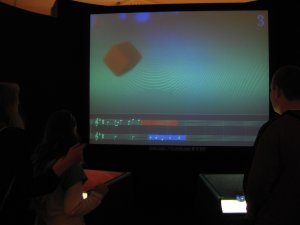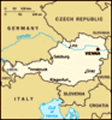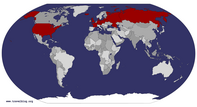Advertisement
Published: April 11th 2009

 Waltz composition game
Waltz composition game
Kids take turns rolling dice; each number adds a musical phrase to their own custom waltz.It
snowed back in Seattle today. Online in the afternoon, I witnessed a flood of Tweets/Facebook stati from home proclaiming it "Mother Nature's April Fool's Joke" (all by people who don't know each other).
Here, our 1. April was utterly free of Aprilscherze (April Fool's Jokes), even from my pun-loving sweetheart, for which I blame residual jet lag. 😊
We set out this morning to visit Greg's #1 destination, the
Haus der Musik interactive museum. It's very much like Seattle's Pacific Science Center but devoted to sound and music. I was surprised when Greg rated it so highly, because it seemed more like a hands-on learning center and more for kids, which is great and all but is not something to which grown-ups necessarily want to devote precious Vienna time. The first few floors of the museum seemed to bear out that suspicion and we were both a little disappointed...
until we discovered the third floor, all of which is devoted to the history, life and music of Wien's Great Composers.
Perhaps because 2009 is the
Haydnjahr (Haydn Year, the 200th anniversary of his death), the first large room was dedicated to
him. Haydn's music played over the speakers, and

 Mozartstühle
Mozartstühle
Leopold, Maria Anna, Wolfgang and Nannerl.interactive computer learning stations (in several languages) allow visitors to learn Haydn's biography and the evolution of his music. A huge timeline mural covered one wall. Furnishings and artifacts were on display throughout the room.
In one corner of the Haydn room, a schoolteacher with a long ponytail, who looked a lot like
Penn Jillette, had a class of pre-teens utterly rapt as he animatedly told some story about (I think) Haydn and the Emperor. He acted out parts, gestured, and did voices for the characters. It looked hilarious and his class seemed to think so too. A few times, he pretended to stumble over or forget a name or place-name, leading the class to all speak up to "remind" him of the correct answer. Genius! I didn't understand a word but could have watched him teach all day. 😊 A different class was running through the Great Composers floor with clipboards, filling out a challenge or quiz; they seemed to be having a good time and learning things, but were a lot more disruptive of us trying to see the exhibits ourselves. "Herr Jillette" kept his class engaged and entertained, but also close-by and well-behaved, a minor miracle for

 Beethoven's hearing
Beethoven's hearing
Each cone plays a Beethoven composition as he would have heard it at the time he composed it.the age group he had to deal with. Kudos to him!
Moving from the Haydn room to the
Mozart room took us through a short, curving passageway. Greg noticed immediately that the sound insulation between rooms was so expertly done that there was no spillover at all of Haydn's music into the Mozart room, nor Mozart's into Haydn's, even without a door between them. The Mozart room had lots of fun displays, including a case of artifacts related to Mozart's affiliation with Freemasonry, a marionette of the Königin der Nacht (Queen of the Night) from
Die Zauberflöte (The Magic Flute), and my favorite, a set of chairs painted to look like the Mozart family from their
classic portrait.
In the
Beethoven room (overrun for a while by clipboard-wielding pre-teens), it took us a moment to figure out that the display with strange cones attached to the wall was an interactive experience of Beethoven's hearing loss: holding each cone to one's ear, one could hear a composition of Beethoven's as it would have sounded to him at the time he composed it, from full hearing through muffled hearing to almost no hearing. At the very end, where 7-8 of his

 Sammiches!
Sammiches!
Open-faced treats at Trzesniewski.works, including some of his best-known, were listed, no sound came out of the cone at all. It was, pardon the pun, profound.
The
Strauss room included a waltz pavilion and video of dancing feet; Greg particularly appreciated the room of
Schönberg and the
Second Viennese School. Kids were playing all over the interactive "conduct the Philharmonic!" exhibit, so we didn't get to try it (which in spite of my comments about the learning center stuff being disappointing, was disappointing). After we finished on the third floor, it was time to head back down to the first floor to watch a film of the famous Neujahrskonzert (New Year's concert) of the
Wiener Philharmoniker (Vienna Philharmonic). We had the screening room entirely to ourselves and the show was a real treat. We liked it so much, we bought a DVD (Region 0, we checked) of it immediately after.
On our way out, we asked the nice cashier dudes at Haus der Musik if they knew where to find a particular open-faced sandwich shop we'd seen on Rick Steves' show, and they in fact knew and gave us precise and excellent directions, which was lucky, so we headed directly there.
(I went

 Stephansdom
Stephansdom
OK, it's a pretty Gothicky center too.to a bunch of trouble to research the name and location of the sandwich shop ahead of time and save it to Google Maps, which was utterly useless once we were out in Vienna because I hadn't written anything down. I truly don't know how to get along anywhere in the world any more without a smartphone, and I haven't figured out how to have a smartphone in Europe yet, which results in me being pathetically disorganized and lost much of the time. Yes, I have heard of this "paper" stuff and these "pen" things.)
Arriving at
Café Trzeṡniewski (which I strongly suspect is not a German/Austrian name 😉 ), we were greeted with yet another
cafeteria-style buffet. Nothing is more terrifying than a charmingly-costumed cafeteria lady saying "Bitte schön?" ("can I help you?") when you are still trying to figure out what planet you are on and which of the things in front of you is actually food. Rick's advice to "point at whatever looks good" was, to us, silly, considering that each of us has
very strong feelings about, for example, herring. Happily, standing back allowed us time to see how the order line worked and also to

 View onto Stephansplatz
View onto Stephansplatz
Gothic cathedral with square and horse-drawn carriages below.discover a full-color menu poster... I don't remember whether it had English on it, but I know enough German food vocabulary to get by. I got my herring and Greg stayed safely herring-free. We also learned that
www.speckmitei.at ("bacon with egg") redirects to Trzeṡniewski's website. 😊
After tasty sammiches, we headed off to my #1 destination,
Stephansdom (Cathedral of St. Stephen), located nearly in the center of the Wiener Altstadt (Vienna's Old Town) inside the Ringstraße (ring road). It's huge, of course, and Gothicky outside with a sweet Baroque center. 😉 I love exploring these old churches, seeing the different architectural and artistic and worship styles on display, and contemplating what the people of its time(s) might have thought about the place. I also love that my little Canon snapshot camera with its image stabilization can pull off reasonable pictures of church interiors without flash!
EuroTravelTipp for touristic cretins: one, it is disrespectful to take flash photographs in a place where people are worshipping, and two, the flash doesn't accomplish anything in a large interior anyway.
Turn off the flash. When the Stephansdom was rebuilt after WWII, many of its destroyed stained-glass windows were replaced with plain

 View over Wien
View over Wien
Prater Riesenrad (ferris wheel) and the double-towered Jesuitenkirche in the distances.pastel glass that Rick Steves refers to, aptly, as "Tupperware-colored". It's awful. I've seen plenty of postwar-restored churches and cathedrals and the rest all seem to have restored their beautiful stained glass as well. I wonder why not here?
In spite of both Greg and I having an embarrassing fear of heights, we decided to brave the elevator to the north tower of the cathedral. Vienna being quite flat, we were pretty sure it'd be a spectacular view. I was
not expecting to step straight out of the Aufzug (elevator car) onto a metal grate that I could look straight through to the ground 65 meters (220 feet) below. Halp!! For some reason, the perfectly obvious existence of extremely sturdy metal railings and screens that literally go all the way up overhead, that I couldn't fall or even
climb over even if I
wanted to, did nothing to settle the Schmetterlinge (butterflies) as I made my way gingerly around the tower on the metal-grate walkway, up some metal-grate stairs, and onto some secure stone. Whew. Up on the landing, a quick look down to the Stephansplatz revealed the source of the strong aroma of horse poo: Fiaker, or horse-drawn

 Kaffee und Kuchen im Café Demel
Kaffee und Kuchen im Café Demel
Nothing more can possibly be said.carriages, lined up on the street directly below. The view from the tower all around Vienna is indeed spectacular, and we also got a close-up look at the Dom's brightly tiled roof and ornate finials and gargoyles, the kinds of things one doesn't normally see from such an angle.
We finished the day at K.u.K Hofzuckerbäcker Ch. Demel's Söhne ("Imperial and Royal Court Confectionery Bakery Ch. Demel's Sons"), also known as Café Demel or just plain
Demel. In this luxurious café, a frivolous little guidebook I had picked up called "Vienna's Top 10" came in wonderfully handy, alerting both of us, with helpful color photos, to the existence of the perfect cakes and perfect coffees for each of us to order. Greg had the super-famous, super-traditional Sachertorte, which is a not-too-sweet chocolate cake covered with beautifully smooth sweet chocolate and a hint of apricot preserve. I had the Eszterházytorte, fine layers of cream alternating with thin layers of a firm, dry, nutty cake that reminded me of a crumb/nut crust one might make for a cheesecake.
For drinks, Demel's menu listed the Großer Brauner (literally, "big brown"), which our guidebook described as "strong coffee with cream", exactly what I wanted, but didn't have a listing for the Großer Schwarzer ("big black", a "strong black coffee") for Greg, so he asked our server for it: "Haben Sie Großer Schwarzer?" She looked absolutely delighted by his German and/or his Viennese cultural knowledge and replied, "Natürlich!" ("Of course!") and asked if he wanted it strong, or not-so-strong. Strong, definitely. We were both then thrilled to discover that our guidebook, obviously written by silly non-Seattle-coffee-drinkers, had omitted an important detail about these Viennese coffees: by "strong coffee" they actually meant a regular-sized cup filled with straight espresso! Unbelievably fantastic. 😊
("Not-so-strong", then, might have meant a Verlängerter, which is a Schwarzer with extra hot water added: in other words, an Americano.)
Jet lag and tired museum feet then won out over cups of delicious caffeine, so we made our way back to the Pension to watch, appropriately enough, President Obama on
his first European visit (as president) on the otherwise quite dreadful CNN International satellite channel. We stopped by a
Billa Lebensmittel (grocery store) for rolls, cheese, wurst and mineral water on the way back to our room... did I mention the mini-fridge?!... and enjoyed an easy late supper later. Guten Abend, bis Morgen (good evening, 'till tomorrow)!
Advertisement
Tot: 0.238s; Tpl: 0.012s; cc: 6; qc: 54; dbt: 0.094s; 1; m:domysql w:travelblog (10.17.0.13); sld: 1;
; mem: 1.2mb










